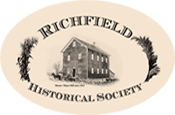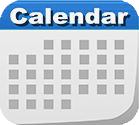A Generation of Oxen
(excerpted from the “Wisconsin Magazine of History” Autumn 2015)
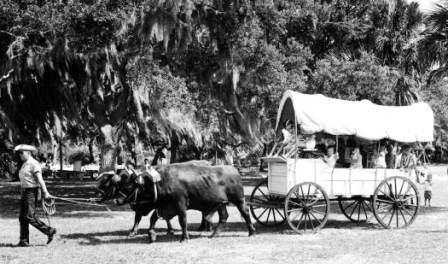 In
the 1840s and 1850s, oxen brought settlers to the opening frontiers of
the upper Midwest. Many farmers arrived in wagons with their
livestock. A milk cow might be tied behind the wagon, with pigs and
chickens in crates bouncing along inside. But, in front pulling it all
were the oxen. They led the way into Wisconsin as they had on other
frontiers throughout history.
In
the 1840s and 1850s, oxen brought settlers to the opening frontiers of
the upper Midwest. Many farmers arrived in wagons with their
livestock. A milk cow might be tied behind the wagon, with pigs and
chickens in crates bouncing along inside. But, in front pulling it all
were the oxen. They led the way into Wisconsin as they had on other
frontiers throughout history.
Pioneers uprooted themselves and their families and relocated to undeveloped areas throughout all of recorded history. Ever since their domestication some 9,000 years ago, cattle have provided power for humans and have always been found on any frontier. They provided meat and milk and played an integral part in the development of farming.
Oxen are not a breed of cattle but rather steers – adult, male bovines that have been castrated. They come from bull calves of any breed of cattle and are castrated and taught to follow voice commands and work with humans. Male cattle are selected because they grow to be larger than the females, and cows are more valuable for their milk and their ability to produce calves.
In nineteenth century Wisconsin, before the rise of the dairy industry, the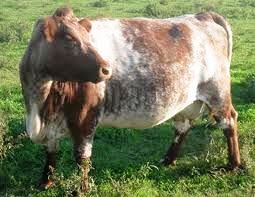 predominant breed of cattle was Shorthorn, an English breed noted for
its meat and milk. Most oxen of that period were at least part
Shorthorn. Today, making cattle into oxen and working with them is a
hobby rather than a necessity, and trainers choose the breed best
suited to the intended use of the animal. Large breeds, such as
Holsteins, are selected for pulling competitions and logging, and small
breeds, like Devons and Jerseys, are more appropriate for farm work.
All cattle raised as oxen must retain their horns which act as brakes
to hold back a load when going downhill. The horns also prevent the
yoke from sliding over the animals’ heads.
predominant breed of cattle was Shorthorn, an English breed noted for
its meat and milk. Most oxen of that period were at least part
Shorthorn. Today, making cattle into oxen and working with them is a
hobby rather than a necessity, and trainers choose the breed best
suited to the intended use of the animal. Large breeds, such as
Holsteins, are selected for pulling competitions and logging, and small
breeds, like Devons and Jerseys, are more appropriate for farm work.
All cattle raised as oxen must retain their horns which act as brakes
to hold back a load when going downhill. The horns also prevent the
yoke from sliding over the animals’ heads.
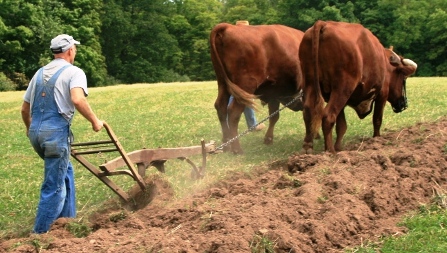 These
steers, trained for work, were the first domesticated animals stronger
than their master, and their strength, once trained and harnessed,
became useful to humans as they transformed their environment into
something more habitable. Ox power revolutionized transport and
agriculture and allowed people to grow more food, transport goods for
trade, and travel over long distances. Oxen were especially adapted to
the environment of an expanding frontier, and their very presence
helped define the frontier experience and westward expansion of the
United States.
These
steers, trained for work, were the first domesticated animals stronger
than their master, and their strength, once trained and harnessed,
became useful to humans as they transformed their environment into
something more habitable. Ox power revolutionized transport and
agriculture and allowed people to grow more food, transport goods for
trade, and travel over long distances. Oxen were especially adapted to
the environment of an expanding frontier, and their very presence
helped define the frontier experience and westward expansion of the
United States.
Oxen were cheaper to buy than horses which made them well suited to the cash-poor economies of the frontier. Although prices might fluctuate, between the 1830s and 1870s, a horse might cost as much as $150, while a team of oxen cost $50. However, it was still an investment in a period when a laborer might make $1.50 in a day and paid $2 for a pair of shoes and ten cents for a pound of butter. For people who had sold almost everything they had to outfit their journey, the investment was worth it and the savings immense.
Frontier farmers were so busy clearing the land and building shelter that growing enough grain to keep a horse in working condition was difficult. Oxen were less expensive to feed since they required no grain to work, and their ruminant digestive systems allowed them to eat and thrive on rougher fodder than any horse could tolerate. The ox’s ability to eat grass along with grain and hay allowed subsistence farmers on the Wisconsin frontier to concentrate on growing crops to feed themselves.
 Harnessing
an ox was also less expensive than equipping a horse. Ox yokes, made of
wood with a few iron fittings, could be easily made with simple tools
and were well within the capabilities of the pioneer farmer. Horse
harnesses, by comparison, were relatively fragile and harder to make
and repair. Although both animals benefit from wearing shoes, oxen are
less likely to develop foot problems by going unshod over long
distances. Since cattle are hardier than horses, they can also get by
with a less refined shelter. When not needed for chores, oxen could be
turned out into the woods to forage for themselves and rounded up again
when there was work to be done.
Harnessing
an ox was also less expensive than equipping a horse. Ox yokes, made of
wood with a few iron fittings, could be easily made with simple tools
and were well within the capabilities of the pioneer farmer. Horse
harnesses, by comparison, were relatively fragile and harder to make
and repair. Although both animals benefit from wearing shoes, oxen are
less likely to develop foot problems by going unshod over long
distances. Since cattle are hardier than horses, they can also get by
with a less refined shelter. When not needed for chores, oxen could be
turned out into the woods to forage for themselves and rounded up again
when there was work to be done.
The fact that horses were faster meant little in an environment where tracks knee deep in mud passed for roads and the market was as far as the next town, a day’s travel away. The slow pace of the ox was better suited to the backbreaking work of carving up a wilderness where speed was less advantageous than the ability to work steadily day in and day out.
Anyone looking at the livestock in Wisconsin in the 1840s would have recognized the region for what it was: a vibrant and expanding frontier where oxen outnumbered horses by virtue of their suitability, necessity, and adaptability to their environment. This is confirmed by the Federal Census of 1850. Oxen comprised fifty-nine percent of all draft animals in the state; 42,801 working oxen as compared to 30,335 horses, asses and mules. Draft animals concentrated in agricultural areas, and in 1850, that was the southeast section of the state. Dane, Dodge, Rock, Washington and Waukesha counties each counted more than 3,000 oxen with the surrounding counties not far behind.
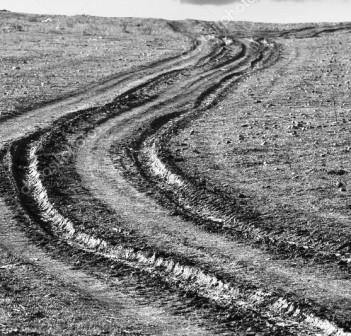 Some
of the first settlers who came into Wisconsin came not to farm but to
mine lead. The farmers that followed found few decent roads but many
tracks through the forest. Early settlers recounted travel as slow and
difficult and nearly or quite impossible in certain seasons. The lack
of good roads meant more to early Wisconsin farmers than just difficult
travel. It also meant difficulty reaching markets. Without markets for
their animals, crops and produce, there was no profitable farming.
Instead, small poorer farms raised a little bit of everything, and the
goods produced were for local or personal consumption. A settler rushed
to build a shelter and clear a patch of land for a first crop, most
likely corn to feed his family and beasts. Oxen excelled at the slow
deliberate work of hauling logs and pulling stones that was the
mainstay of converting forest into field. Trees were cut down, and a
small percentage of them were turned into logs or lumber for building
and fencing. The excess was burned.
Some
of the first settlers who came into Wisconsin came not to farm but to
mine lead. The farmers that followed found few decent roads but many
tracks through the forest. Early settlers recounted travel as slow and
difficult and nearly or quite impossible in certain seasons. The lack
of good roads meant more to early Wisconsin farmers than just difficult
travel. It also meant difficulty reaching markets. Without markets for
their animals, crops and produce, there was no profitable farming.
Instead, small poorer farms raised a little bit of everything, and the
goods produced were for local or personal consumption. A settler rushed
to build a shelter and clear a patch of land for a first crop, most
likely corn to feed his family and beasts. Oxen excelled at the slow
deliberate work of hauling logs and pulling stones that was the
mainstay of converting forest into field. Trees were cut down, and a
small percentage of them were turned into logs or lumber for building
and fencing. The excess was burned.
Often these hardwood forests were the only land that early European immigrants could afford. In contrast, the prairies were more conducive to growing wheat and required less work. Because the prairies had the prospect of quicker returns, they were settled first and often sold at a higher price per acre than the forests.
Even as oxen converted the Wisconsin woods and prairies, agriculture became mechanized. From the decade before Wisconsin became a state until the end of the Civil War, inventive minds and entrepreneurial spirits produced machines for the newly created fields. The machines were also particularly suited and designed to operate at the pace a horse walked. Speed had never been an ox’s strong suit.
Farming methods would eventually leave the use of oxen behind. In 1842, Jerome Increase Case came to the Wisconsin Territory with six groundhog
threshers. He sold five and used the sixth to demonstrate the
mechanical threshing technology. By 1844, he was building improved
threshers at a small factory in the city of Racine. Cyrus McCormick
patented his first reaper, pulled by horses, in 1834 and began to
manufacture them in Chicago in 1848. These two machines, along with a
host of others, transformed Wisconsin agriculture from frontier
subsistence to cash farming and replaced oxen with horses.
Jerome Increase Case came to the Wisconsin Territory with six groundhog
threshers. He sold five and used the sixth to demonstrate the
mechanical threshing technology. By 1844, he was building improved
threshers at a small factory in the city of Racine. Cyrus McCormick
patented his first reaper, pulled by horses, in 1834 and began to
manufacture them in Chicago in 1848. These two machines, along with a
host of others, transformed Wisconsin agriculture from frontier
subsistence to cash farming and replaced oxen with horses.
It wasn’t only technological advances that pushed oxen off the agricultural scene. Attitudes among farmers fostered change just as much as new machinery. As the frontier retreated westward out of Wisconsin, oxen were seen as a thing of the past. Your ancestor may have farmed with oxen, but modern farmers used horses. This technological bias for anything new and improved has always been a part of farming, and oxen were on the short end when it came to modern advances.
The common use of oxen in Wisconsin lasted a little over fifty years as the state was transformed from raw frontier to settled agricultural industry. The only constant was change, as wheat replaced forest and prairie only to be supplanted by the dairy cow. Oxen are remembered today through historical documents and museum displays. Little physical evidence remains of their primary role in the creation of Wisconsin agriculture. Their legacy remains evident in the smooth broad fields of Wisconsin farms and the tractors that continue the work the oxen started.
Hope you enjoyed this story
Enjoy our other stories
